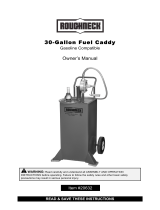Page is loading ...

LOW- P R O F I L E D R U M C A D D Y
OWNER’S MANUAL
WARNING: Read carefully and understand all
INSTRUCTIONS before operating. Failure to follow the
safety rules and other basic safety precautions may result
in serious personal injury.
Item # 103184

Page of 5
2
Thank you very much for choosing a Northern Industrial Tools™ product! For future reference,
please complete the owner’s record below:
Model: _______________ Purchase Date: _______________
Save the receipt, warranty and these instructions. It is important that you read the entire manual
to become familiar with this product before you begin using it.
This product is designed for certain applications only. The distributor cannot be responsible for
issues arising from modification. We strongly recommend this product not be modified and/or
used for any application other than that for which it was designed. If you have any questions
relative to a particular application, DO NOT use the product until you have first contacted the
distributor to determine if it can or should be performed on the product.
For technical questions please call 1-800-222-5381.
INTENDED USE
This low-profile drum caddy can easily transport steel, plastic or fiber drums. The removable handle
can built in bung nut wrench and seal remover.
.
TECHNICAL SPECIFICATIONS & PACKING LIST
Item
Description
Load Capacity
1100 lbs. (500kg)
Transport Capacity
30- or 55-gallon drums
Finish
Powder-coat
GENERAL SAFETY RULES
WARNING: Read and understand all instructions. Failure to follow all instructions listed
below may result in serious injury.
WARNING: The warnings, cautions, and instructions discussed in this instruction
manual cannot cover all possible conditions or situations that could occur. It must be
understood by the operator that common sense and caution are factors which cannot be built into
this product, but must be supplied by the operator.
SAVE THESE INSTRUCTIONS
WORK AREA
• Keep work area clean, free of clutter and well lit. Cluttered and dark work areas can cause
accidents.
• Keep children and bystanders away while using the drum caddy. Distractions can cause
you to lose control, so visitors should remain at a safe distance from the work area.
• Be aware of all power lines, electrical circuits, water pipes and other mechanical hazards
in your work area, particularly those hazards below the work surface hidden from the

Page of 5
3
operator’s view that may be unintentionally contacted and may cause personal harm or
property damage.
• Be alert of your surroundings. Using a drum caddy in confined work areas may put you
dangerously close to cutting tools and rotating parts.
PERSONAL SAFETY
• Use personal protective equipment. Always wear eye protection. Safety equipment
such as dust mask, non-skid safety shoes, hard hat, or hearing protection used for
appropriate conditions will reduce personal injuries.
• Do not overreach. Keep proper footing and balance at all times. This enables better
control of the drum caddy in unexpected situations.
• Dress properly. Do not wear loose clothing or jewelry. Keep your hair, clothing and
gloves away from moving parts. Loose clothes, jewelry or long hair can be caught in
moving parts.
USE AND CARE
• Never exceed the maximum capacity of 1100 lbs..
• Never load more than one drum at a time.
• Never load the unit unless you are watching it.
• Stand clear of drum while loading and unloading.
• Drum must be pushed all the way to the back of the cradle before moving.
• Use caution in moving a loaded unit; avoid obstructions and floor defects.
• Wear steel-toe shoes when operating.
OPERATION
• Align unit front of drum, remove handle, grip drum with handle.
• Tip drum up while guiding the cradle under the drum.
• Reattach handle and transport drum to desired location.
MAINTENANCE
• Maintain your drum caddy. Before each use, inspect the general condition of the drum
caddy. Check for loose hardware, misalignment or binding of moving parts, cracked or
broken parts, damaged electrical wiring, and any other condition that may affect its safe
operation.
• Keep all moving parts lightly lubricated to prevent corrosion.
• After use, wipe external surfaces of the tool with clean cloth.

Page of 5
4
DIAGRAM & PARTS LIST
Part#
Description
Qty.
1
Handle Grip
2
2
Handle
1
3
Lock Nut
4
4
Bolt
4
5
Cradle Assembly
1
6
Washer
4
7
Rear Caster
2
8
Lock Nut
2
9
Wheel
2
For replacement parts and technical questions, please call 1-800-222-5381.

Page of 5
5
WARRANTY
One year limited warranty
Distributed by
Northern Tool + Equipment Co.,
Distributed by
Northern Tool + Equipment Co., Inc.
Burnsville, MN 55306-6936
Made in China
/




